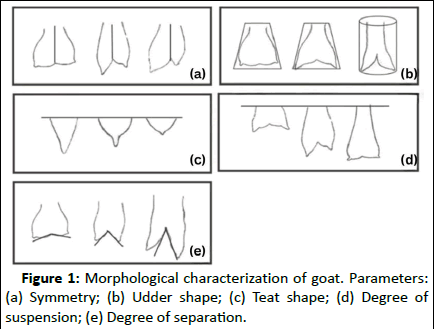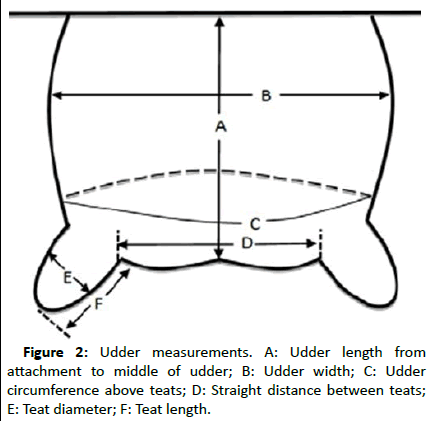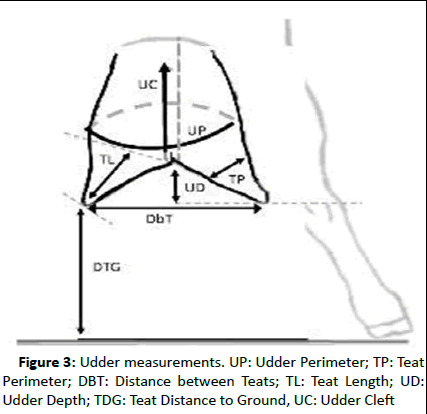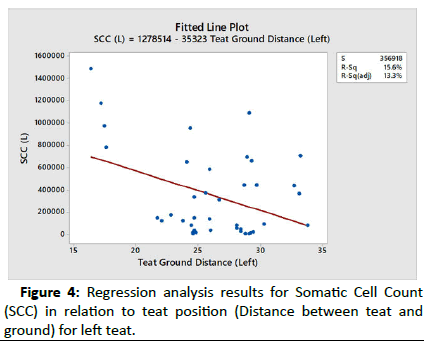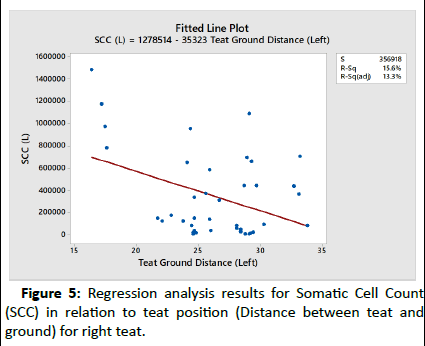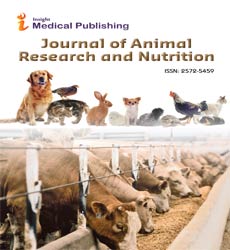Udder Morphology, Milk Quality and Milk Composition of Saanen Goat at NGRP Bandipur
Dr. Ayush Adhikari and Dr. Sagun Malla
Received Date: 2023-12-11 | Published Date: 2025-02-10Ayush Adhikari1*, Sagun Malla2
1Department of Veterinary and Animal Sciences, Nepal Polytechnic Institute, Bharatpur, Chitwan, Nepal
2Department of Animal Science, National Cattle Research institute, Rampur, Nepal
- Corresponding Author:
- Ayush Adhikari
Department of Veterinary and Animal Sciences
Nepal Polytechnic Institute
Bharatpur, Chitwan, Nepal
E-mail: ayush.adhikari2000@gmail.com
Received date: December 11, 2023, Manuscript No. IPJARN-23-18195; Editor assigned date: December 14, 2023, PreQC No. IPJARN-23-18195 (PQ); Reviewed date: December 30, 2023, QC No. IPJARN-23-18195; Revised date: February 03, 2025, Manuscript No. IPJARN-23-18195 (R); Published date: February 10, 2025, DOI: 10.36648/2572-5459.10.1.146
Citation: Adhikari A, Malla S (2025) Udder Morphology, Milk Quality and Milk Composition of Saanen Goat at NGRP Bandipur. J Anim Res Nutr Vol:10 No:1
Abstract
Goat farming plays a crucial role in meeting global demands for meat and dairy products, especially in Nepal, where it contributes significantly to agricultural GDP and rural livelihoods. The introduction of Saanen goats, known for their prolific milk production, has the potential to revolutionize goat farming in Nepal. This study, carried out over a 28-day period involving 10 Saanen goats at the late lactation stage assesses udder morphology, milk composition, and milk quality in Saanen goats at the national goat research program, Bandipur, Nepal. The results indicate that most goats have symmetrical, globular udders and funnel shaped teats. Somatic Cell Count (SCC) values consistently remained within the normal range throughout the duration of the study, with the notable observation that SCC values were higher in the right teat (1137242 cells/ml) compared to left teat (352676 cells/ml) and teat-to-ground distance notably impacted SCC, especially in the left teat. The right teat did not significantly affect SCC, possibly due to individual variations. Milk composition remained stable, with minor fluctuations, and physical udder measurements showed significant variations in udder circumference and width, possibly linked to milk production. The study highlights the potential for sustainable high-quality milk production in Saanen goats in Nepal and offers insights for early health issue detection, fostering effective herd management and productivity. Further research with larger sample sizes and different lactation stages can provide more comprehensive insights into Saanen goat farming in Nepal.
Keywords
Milk composition; Milk quality; Somatic cell count; Saanen goats; Udder morphology
Introduction
Goat farming constitutes an integral pillar of the global livestock industry, effectively meeting the escalating demand for meat and dairy products while concurrently offering sustainable income prospects to millions of households worldwide.
According to the food and agriculture organization of the United Nations, globally, the dairy goat population reached 218 million in 2017, with Asia and Africa holding a substantial majority, with 52% and 39%, respectively. Over the last decade (200-2017), there was a remarkable 22% increase in the worldwide dairy goat population, reflecting the broader surge in the global goat population, now totaling approximately one billion goats [1].
In Nepal, goat farming is a vital component of the agricultural landscape, with a population of around 13,442,614 goats as of 2021. This sector contributes approximately 3.17% to Nepal's agricultural gross domestic product and serves as a crucial income source for rural communities, especially in remote areas. Goat’s adaptability to diverse terrains and climates allows them to thrive in mountains, hills, and plains. As farmers tend to their herds, they not only secure their livelihoods but also enhance food security. Furthermore, goat milk and its derivatives, like cheese and yogurt, enrich local markets, adding value to Nepal's agriculture.
The Saanen goat, originating from Switzerland, is esteemed for its milk production. The introduction of Saanen goats to Nepal in 2014, facilitated by a world bank-funded initiative, marked a significant moment for the country's goat farming. The government, particularly the ministry of agriculture and livestock development, along with the National goat research program in Bandipur, has been actively promoting Saanen goat production. These goats are renowned for their impressive milk production, with a single doe yielding up to 3 gallons of milk of nutritious milk daily (A-Z animals, 2023), rich in fat and protein. Moreover, Saanen goats are easy to care for and adaptable to diverse climates, thriving on various feeds. Although not widely recognized in Nepal, they are gaining momentum due to their adaptability and numerous advantages. Their introduction offers a substantial opportunity to boost milk production, raise farmer incomes and improve the population's nutrition. As awareness grows and their adaptability becomes more apparent, Saanen goats hold high prospects for further growth within Nepal's agricultural sector [2].
The udder serves as a pivotal gland in the reproductive process of animals, particularly in relation to milk production.
Numerous studies have underscored the significance of udder and teat characteristics as key determinants of both milk yield and the ease of milking, directly impacting the milking ability of dairy animals. Presently, there is a growing body of research aimed at exploring diverse factors contributing to udder morphology variability within the context of milk production and mammary gland health.
Saanen goats have distinct characteristics when it comes to udder health and milk production. According to Santos, et al. most udder morphological traits in Saanen goats were not significantly related to the number of somatic cells in milk. However, there was a noteworthy observation regarding udder circumference. This trait was found to be negatively correlated with the number of somatic cells in milk. Similarly, a study by Poonia, et al. found that healthy animals had a higher teat floor distance compared to sub clinical mastitis affected animals which suggests that pendulous udders are more susceptible to subclinical mastitis. Furthermore, Rupp, et al. conducted research on teat size and its relationship with somatic cell counts in Saanen goats. They found a significant phenotypic correlation between somatic cell count in milk and teat size in Saanen goats. Specifically, shorter and narrower teats were associated with fewer somatic cells in the milk of Saanen goats. This correlation was not observed in French alpine goats, suggesting that the relationship between teat size and somatic cell count may vary between different goat breeds [3].
In high-yielding dairy goats, the characteristics of the udder including size, shape and teat morphology have a significant impact on milk production. Montaldo and Martinez-Lozano conducted research on udder morphology and its connection to milk production in dairy goats. According to their findings, a round shaped udder, resembling a bowl shape, was considered the most desirable for milk production. Similarly, external measures defining udder size, such as udder circumference, depth, and width, have also been studied for their correlation with milk yield. Cedden, et al. and Upadhyay, et al. reported high phenotypic correlations (ranging from 0.6 to 0.8) between these external udder measures and milk yield.
However, Cividini, et al. noted a signi icant negative correlation between udder depth and udder width with the duration of lactation in French alpine goats. Similarly, lactation order, lactation stage, litter size, and milking frequency are additional factors in luencing goat udder morphology. Montaldo and Martinez-Lozano found that goats in later lactations tended to have longer teats, smaller udder circumferences, and shorter distances from the teat ends to the loor compared to first parity goats. Additionally, goats milked once daily exhibited differences in udder volume, udder circumference, udder depth, and teat positioning compared to those milked twice daily.
The present study will be aimed at assessing udder morphology, milk composition, and milk quality of Saanen goats at NGRP, Bandipur, Nepal. The specific objectives of this study include examining variations in udder size and shape among Saanen goats. Additionally, the study will analyze various milk composition parameters and assess milk quality by examining Somatic Cell Counts (SCC) in the milk produced by these Saanen goats. Through these objectives, the research aims to provide valuable insights into the udder characteristics and milk production capabilities of Saanen goats, contributing to the advancement of goat farming practices in Nepal.
Materials and Methods
Study animals and sampling period
For this study, a total of 10 lactating Saanen goats from the national goat research program, Bandipur, Nepal, were randomly selected as the study animals. These goats were in the late lactation stage and had an age range of 2 to 3 years. The data collection spanned a period of 28 days, during which milk yield data was recorded daily, while other measurements were taken once a week over the course of 4 weeks. The research was conducted from Mid-Shrawan to Mid-Bhadra, 2080 (Nepali calendar) [4].
Udder morphology
Udder morphology traits were assessed through a combination of visual evaluation and physical measurements. For visual evaluation, five parameters of udder morphology were used, and the udders were classified based on the following criteria: Symmetry (Symmetrical, moderate and asymmetrical), shape (Globular, pear and cylindrical) and degree of separation (Slight, moderate, severe), degree of suspension (Extremely snug, intermediate, pendulous) and teat shape (Funnel, bottle, balloon) as shown in Figure 1. These criteria were adapted from Montaldo and Martínez-Lozano [5].
Figure 1: Morphological characterization of goat. Parameters: (a) Symmetry; (b) Udder shape; (c) Teat shape; (d) Degree of suspension; (e) Degree of separation.
Similarly, physical measurements of the udder were taken prior to milking. These measurements were recorded following parameters illustrated in Figures 2 and 3, as described by Merkhen, et al. and Montaldo and Martínez-Lozano respectively. The animals were kept in a standing position on a level surface to ensure accuracy, and the following udder parameters were recorded using a measuring tape udder circumference, udder cleft, udder width, udder length, udder depth (both right and left teats), distance between teats, and teat distance to the ground (both left and right sides). Teat length, teat width at the base, and teat breadth for both left and right teats were measured using a vernier caliper [6].
Figure 2: Udder measurements. A: Udder length from attachment to middle of udder; B: Udder width; C: Udder circumference above teats; D: Straight distance between teats; E: Teat diameter; F: Teat length.
Figure 3: Udder measurements. UP: Udder Perimeter; TP: Teat Perimeter; DBT: Distance between Teats; TL: Teat Length; UD: Udder Depth; TDG: Teat Distance to Ground, UC: Udder Cleft
Milk sampling
Milk samples were collected from each goat, with samples taken from both teats to ensure a comprehensive analysis. Before sampling, thorough hygiene practices were observed to maintain the integrity of the samples. The teat ends were carefully cleaned with water and the initial strips of milk were discarded to eliminate any potential contaminants. Subsequently, 20 ml of milk from each teat was collected in sterile plastic containers. The collected milk samples were carefully stored in an ice box and then transported to the National cattle research program in Rampur, Chitwan, to undergo further analysis and processing on the same day of collection.
Milk composition analysis
Each container containing milk was thoroughly stirred to ensure homogeneity. Subsequently, the milk composition parameters, including protein, lactose, Solids-Not-Fat (SNF), fat, total solids and salt, were analyzed using an ultrasonic milk analyzer, specifically the milkotester-master eco. The analysis was conducted in strict adherence to the manufacturer's instructions to maintain consistency and accuracy [8].
Statistical analysis
The data collected in this study were entered into MS excel 2019 to ensure accurate organization and preparation. Subsequently, comprehensive statistical analysis was conducted using Minitab 17. Descriptive statistics, both for overall and weekly data, were computed to gain a comprehensive understanding of the dataset. To assess the significance of weekly differences among the various parameters, a general linear model Analysis of Variance (ANOVA) was employed. A critical threshold of p ≤ 0.05 was used to determine statistical significance. If the p-value fell at or below this threshold, the observed differences were considered significant. In such cases, post hoc comparisons were performed using the Tukey post hoc test to discern specific variations among the variables. Furthermore, regression analysis was carried out to investigate the relationship between teat distance to the floor (both left and right teats) and somatic cell count of the corresponding teats. Fitted line plots were generated to visualize the nature of this relationship.
Results
The combined information from Tables 1 and 2 provides overview of udder and teat characteristics in lactating Saanen goats. In terms of udder symmetry and shape, the majority of goats exhibited symmetrical udders (eight goats) with a globular shape (eight goats). One goat had an asymmetrical udder, and two goats displayed pear shaped udders, while one goat showed moderate udder symmetry. Additionally, the degree of separation and suspension of udders varied, with eight goats having slight separation, two showing moderate separation, six displaying intermediate suspension, and four having pendulous suspension. Teat shapes were predominantly funnel shaped, with eight goats having funnel-shaped teats on both the left and right sides, while two goats had bottle shaped teats bilaterally [9].
| Udder symmetry | Asymmetrical | 1 |
| Symmetrical | 8 | |
| Udder shape | Moderate | 1 |
| Pear | 2 | |
| Degree of separation | Globular | 8 |
| Slight | 8 | |
| Degree of suspension | Moderate | 2 |
| Intermediate | 6 | |
| Pendulous | 4 |
Table 1: Udder symmetry, shape, degree of separation and degree of suspension.
| Teat | ||
|---|---|---|
| Teat shape | Left | Right |
| Funnel | 8 | 8 |
| Bottle | 2 | 2 |
Table 2: Teat shape of lactating saanen goats.
In Table 3, the results of the California Mastitis Test (CMT) for the left and right teats of lactating Saanen goats are presented. The outcomes include negative results, as observed in 15 goats for the left teat and 7 goats for the right teat. Additionally, varying levels of CMT results were noted level 1, which occurred in 13 goats for the left teat and 10 goats for the right teat; level 2, observed in 11 goats for the left teat and 15 goats for the right teat; and level 3, detected in only 1 goat for the left teat and 8 goats for the right teat [10].
| Teat | ||
| CMT result | Left | Right |
| Negative | 15 | 7 |
| 1 | 13 | 10 |
| 2 | 11 | 15 |
| 3 | 1 | 8 |
Table 3: CMT results of left and right teats.
Table 4 presents information about milk yield and composition for the left and right teats of lactating Saanen goats over a four-week period, along with corresponding statistical analysis results. In terms of milk yield, the overall milk yield averaged 1.1282 ± 0.02 liter/day, with weekly variations observed across the four weeks. Regarding milk composition, various parameters were analyzed, including fat, Solids-Not-Fat (SNF), protein, lactose, total solids, and salt content. Thestatistical analysis revealed that there were no significant differences in fat, SNF, protein, lactose, total solid and salt content of left and right teats, as indicated by F-values and p values above the threshold of 0.05 [11].
| Milk yield (l/d) | Fat (%) | SNF (%) | Protein (%) | Lactose (%) | Total solid (%) | Salt (%) | |||||||
| Left | Right | Left | Right | Left | Right | Left | Right | Left | Right | Left | Right | ||
| Overall | 1.128 ± 0.020 | 3.614 ± 0.153 | 3.274 ± 0.213 | 8.402 ± 0.132 | 8.340 ± 0.153 | 3.054 ± 0.051 | 3.044 ± 0.574 | 4.788 ± 0.076 | 4.390 ± 0.068 | 12.016 ± 0.205 | 11.619 ± 0.251 | 0.678 ± 0.011 | 0.675 ± 0.012 |
| Week 1 | 1.190 ± 0.049 | 3.684 ± 0.372 | 3.439 ± 0.437 | 8.894 ± 0.386 | 8.786 ± 0.412 | 3.248 ± 0.143 | 3.232 ± 0.146 | 4.830 ± 0.218 | 4.345 ± 0.131 | 12.578 ± 0.599 | 12.225 ± 0.592 | 0.727 ± 0.0317 | 0.717 ± 0.034 |
| Week 2 | 1.080 ± 0.339 | 3.539 ± 0.324 | 3.145 ± 0.381 | 8.301 ± 0.218 | 8.170 ± 0.351 | 3.026 ± 0.084 | 2.989 ± 0.130 | 4.704 ± 0.145 | 4.306 ± 0.109 | 11.840 ± 0.315 | 11.335 ± 0.517 | 0.671 ± 0.018 | 0.660 ± 0.029 |
| Week 3 | 1.108 ± 0.039 | 3.617 ± 0.277 | 3.302 ± 0.505 | 8.429 ± 0.187 | 8.351 ± 0.214 | 3.067 ± 0.079 | 3.056 ± 0.080 | 4.624 ± 0.130 | 4.540 ± 0.189 | 12.046 ± 0.29 | 11.653 ± 0.449 | 0.672 ± 0.017 | 0.674 ± 0.017 |
| Week 4 | 1.134 ± 0.035 | 3.615 ± 0.291 | 3.209 ± 0.435 | 7.985 ± 0.147 | 8.053 ± 0.175 | 2.877 ± 0.069 | 2.900 ± 0.076 | 4.996 ± 0.077 | 4.369 ± 0.115 | 11.600 ± 0.355 | 11.262 ± 0.458 | 0.644 ± 0.012 | 0.651 ± 0.014 |
| F-Value | 1.37 | 0.03 | 0.08 | 2.25 | 1.12 | 2.41 | 1.56 | 1.15 | 0.55 | 1.04 | 0.75 | 2.68 | 1.36 |
| p-Value | 0.253 | 0.991 | 0.969 | 0.099 | 0.354 | 0.083 | 0.215 | 0.341 | 0.653 | 0.387 | 0.531 | 0.061 | 0.271 |
| Sig. level | Ns | ns | ns | ns | ns | ns | Ns | ns | Ns | ns | ns | ns | ns |
Table 4: Overall and weekly averages of milk composition parameters with F-value and p-value analysis.
Table 5 provides detailed overview of milk quality parameters for the left and right teats of lactating Saanen goats, along with the corresponding statistical analysis results. In terms of milk quality parameters, the Somatic Cell Count (SCC) showed variations over the study period, with an overall SCC of 352,676 ± 60,625 cells/ml for the left teat and 1,137,242 ± 210,707 cells/ml for the right teat. Similarly, pH levels in milk from both teats displayed slight variations, with an overall pH of 6.6858 ± 0.0409 for the left teat and 6.7260 ± 0.0395 for the right teat. Conductivity values fluctuated over time, with an overall conductivity of 5.438 ± 0.102 mS/cm for the left teat and 6.361 ± 0.189 mS/cm for the right teat. Freezing point values exhibited slight fluctuations, with an overall freezing point of -0.5345 ± 0.0092°C for the left teat. However, statistical analysis indicated non-significant differences (p>0.05) between the milk quality parameters of left and right teats over the four-week study period [12].
| SCC (104 cells/ml) (logSCC) | pH | Conductivity (mS/cm) | Freezing point (°C) | |||||
| Left | Right | Left | Right | Left | Right | Left | Right | |
| Overall | 35.2676 ± 6.0625 | 113.7242 ± 21.0707 | 6.6858 ± 0.0409 | 6.7260 ± 0.0395 | 5.438 ± 0.102 | 6.361 ± 0.189 | -0.5345 ± 0.0092 | -0.5287 ± 0.0106 |
| Week 1 | 41.6711 ± 14.6389 | 116.1758 ± 33.4628 | 6.8080 ± 0.0634 | 6.7800 ± 0.0757 | 5.349 ± 0.226 | 6.265 ± 0.346 | -0.5696 ± 0.0267 | -0.562 ± 0.0284 |
| Week 2 | 31.4087 ± 11.5750 | 151.9492 ± 63.1931 | 6.6470 ± 0.0803 | 6.6870 ± 0.0856 | 5.379 ± 0.122 | 6.527 ± 0.443 | - 0.5271 ± 0.0148 | -0.5164 ± 0.0247 |
| Week 3 | 32.6330 ± 11.6342 | 91.7820 ± 30.2747 | 6.6480 ± 0.0897 | 6.7110 ± 0.0852 | 5.532 ± 0.243 | 6.321 ± 0.374 | -0.5355 ± 0.0132 | -0.5273 ± 0.0141 |
| Week 4 | 35.3578 ± 12.1015 | 94.9899 ± 37.5544 | 6.6400 ± 0.0912 | 6.6860 ± 0.0775 | 5.493 ± 0.23 | 6.332 ± 0.401 | -0.5058 ± 0.0112 | -0.5089 ± 0.012 |
| F-Value | 0.13 | 0.41 | 0.99 | 0.3 | 0.17 | 0.08 | 2.28 | 1.25 |
| p-Value | 0.94 | 0.745 | 0.408 | 0.827 | 0.913 | 0.968 | 0.095 | 0.305 |
| Sig. level | ns | ns | ns | ns | ns | ns | ns | ns |
Table 5: Overall and weekly averages of milk quality parameters with F-value and p-value analysis.
Table 6 presents overview of udder and teat measurements for lactating Saanen goats over a four-week period. These measurements encompass udder circumference, udder cleft, udder length, udder width, udder depth (for both teats), distance between teats, and various teat characteristics such as length, width at the base, breadth, and distance from the ground. Noteworthy findings include variations in udder circumference (F=3.48, p=0.026) and udder width (F=3.22, p=0.034) across the four weeks, with different superscript letters "a" and "b" indicating significant differences between specific weeks, as revealed by the Tukey post hoc test. However, other measurements did not show significant differences (p>0.05) over the study period [13].
| Udder circumference (cm) | Udder cleft (cm) | Udder length (cm) | Udder width (cm) | Udder depth to right (cm) | Udder depth to left (cm) | Distance between teats (cm) | Teat length | Teat width at base | Teat breadth | Distance between teat and ground | |||||
| Left (cm) | Right (cm) | Left (cm) | Right (cm) | Left (cm) | Right (cm) | Left (cm) | Right (cm) | ||||||||
| Overall | 44.86 ± 1.01 | 23.45 ± 0.476 | 11.787 ± 0.326 | 13.883 ± 0.397 | 14.473 ± 0.407 | 13.79 ± 0.354 | 11.613 ± 0.433 | 4.924 ± 0.226 | 4.969 ±0.165 | 3.089 ± 0.204 | 3.015 ± 0.111 | 2.629 ± 0.171 | 2.579 ± 0.106 | 26.211 ± 0.677 | 26.173 ± 0.585 |
| Week 1 | 46.57a ± 1.88 | 24.26 ± 0.844 | 11.97 ± 0.705 | 14.46 a ± 0.764 | 15.1 ± 0.83 | 14.24 ± 0.707 | 12.06 ± 0.912 | 5.29 ± 0.466 | 5.12 ± 0.283 | 3.247 ± 0.480 | 3.06 ± 0.189 | 2.607 ± 0.374 | 2.572 ± 0.214 | 25.86 ± 1.43 | 26.59 ± 1.15 |
| Week 2 | 39.7b ± 1.63 | 21.21 ± 0.909 | 11.14 ± 0.209 | 11.91 b ± 0.321 | 12.54 b ± 0.376 | 12.4 ± 0.565 | 10.15 ± 0.473 | 3.903 ± 0.175 | 4.354 ± 0.404 | 2.629 ± 0.095 | 2.776 ± 0.187 | 2.619 ± 0.31 | 2.465 ± 0.201 | 25.96 ± 1.36 | 25.4 ± 1.31 |
| Week 3 | 46.48a ± 1.91 | 24.22 ± 0.912 | 12.02 ± 0.757 | 14.48 a ± 0.868 | 15.15 ± 0.855 | 14.21 ± 0.716 | 12.11 ± 0.957 | 5.283 ± 0.487 | 5.222 ± 0.296 | 3.246 ± 0.440 | 3.159 ± 0.256 | 2.669 ± 0.341 | 2.688 ± 0.223 | 26.95 ± 1.41 | 26.63 ± 1.03 |
| Week 4 | 46.7 a ± 1.95 | 24.11 ± 0.902 | 12.02 ± 0.813 | 14.68 a ± 0.848 | 15.1 ± 0.869 | 14.31 ± 0.746 | 12.13 ± 0.978 | 5.219 ± 0.492 | 5.18 ± 0.287 | 3.23 ± 0.504 | 3.066 ± 0.260 | 2.62 ± 0.394 | 2.589 ± 0.238 | 26.09 ± 1.4 | 26.07 ± 1.31 |
| F-value | 3.48 | 2.81 | 0.42 | 3.22 | 2.87 | 1.82 | 1.3 | 2.55 | 1.64 | 0.55 | 0.54 | 0.01 | 0.17 | 0.13 | 0.23 |
| p-value | 0.026 | 0.053 | 0.739 | 0.034 | 0.06 | 0.161 | 0.289 | 0.071 | 0.197 | 0.652 | 0.658 | 0.99 | 0.914 | 0.943 | 0.877 |
| Sig. level | * | ns | ns | * | ns | ns | ns | ns | ns | ns | ns | ns | ns | ns | ns |
Table 6: Overall and weekly averages of udder morphology parameters with F-value and p-value analysis.
Figures 4 and 5 explains about the regression analysis conducted with Somatic Cell Count (SCC) as the dependent variable and 'distance between teat and ground' as the independent variable. The negative coefficient of -35,323 units for the left teat suggests that as the distance between the left teat and the ground decreases, there is a corresponding increase in SCC. On the other hand, for the right teat, the negative coefficient of -97,139 units, although numerically larger than the left teat, is not statistically significant (p=0.093) [14].
Figure 4: Regression analysis results for Somatic Cell Count (SCC) in relation to teat position (Distance between teat and ground) for left teat.
Figure 5: Regression analysis results for Somatic Cell Count (SCC) in relation to teat position (Distance between teat and ground) for right teat.
Discussion
The results of our study suggest that the majority of lactating Saanen goats (80%) have symmetrical udders with a globular shape. This finding aligns with the breed standard, which describes the ideal Saanen udder as round or globular, and not pendulous or 'split' between the halves, as described by NSW department of primary industries (n.d.). Additionally, Montaldo and Martínez-Lozano also emphasized the advantages of round shaped udders, similar to a bowl, for milk production and mammary gland health. The degree of separation and suspension of udders varied among the goats in this study, with slight separation and intermediate suspension being the most common. The variation in udder separation and suspension observed among the goats in our study can be attributed to multiple factors, including genetics, nutrition, and management practices. This is in line with findings from Rupp, et al. who investigated udder type traits in dairy alpine and Saanen goats. Their research revealed moderate heritability estimates for various udder type traits, ranging from 0.22 to 0.50. Similarly, we found that teat shape was predominantly funnel shaped (80%), with only two goats having bottle-shaped teats bilaterally. This is also consistent with the breed standard, which describes the ideal Saanen teat as being funnel shaped and of moderate size. Similarly, the physical measurements of lactating Saanen goats (Table 3) revealed significant weekly variations in udder circumference and udder width, but not in udder cleft, udder length, udder depth to right and left, distance between teats, teat length, teat width at base, teat breadth, or distance between teat and ground over a four week period. The significant finding may be attributed to the correlation between udder size and milk yield. Previous research conducted by Iñiguez, et al. revealed positive and moderate to strong correlations (r=0.36 to 0.76) between udder circumference, width, and milk production traits. Thus, the fluctuations in udder circumference and udder width could be reflective of underlying changes in milk production. On the other hand, the absence of significant variations in the remaining udder and teat measurements may find explanation in the uniform lactation stage of our study subjects. Castro, et al. have reported the influence of age and lactation stage on morphological features in goats, and given that our study comprised goats of a similar age range (2-3 years) and lactation stage, their morphological features may have been less variable [15].
California mastitis test revealed that out of a total of 30 goats, only 13 goats (43.3%) had a positive CMT result on at least one teat. Of these, 11 goats (36.7%) had a level 1 CMT result, 15 goats (50%) had a level 2 CMT result, and 8 goats (26.7%) had a level 3 CMT result. It is important to note that the CMT is a screening test, and a positive result does not necessarily mean that a goat has mastitis. However, it does indicate that the goat may have an increased risk of developing mastitis. We observed that the Somatic Cell Count (SCC) in the left teat was approximately 352,676 cells/mL, while in the right teat, it was slightly higher at around 113,724 cells/ml. It's worth noting that both of these values fell within the normal range for goats. According to research by Paape, et al. SCC in goat milk can vary from 270 × 103 to 2000 × 103 cells/ml without indicating mastitis. It's important to mention that goat milk can contain around 150 × 103/mL of cytoplasmic particles, which may be mistaken for somatic cells. The higher prevalence of positive CMT results and Somatic cell count was found on the right teat compared to the left teat. This observation aligns with a previous study by Mbindyo, which linked a higher rate of udder infections in the left udder of goats to the order of milking. He suggested that the teat milked first could be more prone to infection than the one milked later. Similarly, we carried out the regression analysis and found that the distance between the teat and the ground is a significant factor in determining the Somatic Cell Count (SCC) of goat milk. The negative coefficient for the left teat suggests that as the distance between the left teat and the ground decreases, the SCC increases. A study by Poonia, et al. also found the similar result. They found that healthy animals had a higher teat floor distance compared to sub clinical mastitis affected animals which suggests that pendulous udders are more susceptible to subclinical mastitis. This is likely because the teats are more likely to come into contact with dirt and bacteria when they are close to the ground. Interestingly, the distance between the right teat and the ground did not seem to have a significant effect on SCC. This suggests that other factors may be contributing to the higher SCC in the right teat. These factors could include differences in the health of individual goats, milking practices, behavior, or environmental conditions [16].
Similarly, we assessed the pH levels of the milk, finding that the left teat had a pH of approximately 6.685 ± 0.0409, while the right teat had a pH of about 6.726 ± 0.0395. Our findings align with studies by Mahmood and Usman and Kljajevic, et al. which reported pH values in the similar range for goat milk. Mahmood and Usman found pH values between 6.48 and 6.64, while Kljajevic, et al. noted a range of 6.69 to 6.73 for Saanen goat milk. We also examined the Electrical Conductivity (EC) of the milk, observing a value of approximately 5.438 ± 0.102 mS/cm in the left teat and 6.361 ± 0.189 mS/cm in the right teat. Diaz, et al. and Ying, et al. have reported similar findings regarding EC in goats. Diaz, et al. found values ranging from 5.01 to 5.63 mS/cm, while Ying, et al. reported the EC of healthy Saanen goat milk as 5.6 mS/cm. Notably, the slightly elevated EC in the right teat compared to the left teat may be linked to the positive correlation between SCC and EC, as observed by Ying, et al. [17].
Who noted an increase in EC with infection in Saanen goats. Additionally, we determined the freezing point of the milk, finding it to be approximately -0.5345 ± 0.0092°C in the left teat and -0.5287 ± 0.0106°C in the right teat. Our results are consistent with the findings of Janstova, et al. who reported the freezing point of raw goat milk to be between -0.570 and -0.610 degrees Celsius.
Likewise, we recorded an overall average milk yield of 1.1662± 0.02 litres/day. Ibrahim and Jalil reported that does in mid lactation produce the highest milk yield, followed by does in early lactation and late lactation, respectively. Similarly, Zailan and Yaakub found that the peak of milk production in Jamanapari goats occurred during mid-lactation, followed by early lactation and late lactation. As all the goats in our study were in late lactation, which could explain the comparatively lower milk yield when compared to Ferro, et al. study, where an average Saanen milk yield of 2.55 kg/day was reported. Furthermore, differences in daily milk yield compared to studies by Bolacali and Küçük, Norris, et al. and Boro, et al. underscore the role of various factors, including dietary management and regional disparities, in influencing milk yield outcomes. Additionally, our results indicate stability in milk yield with no significant differences over the four-week study period, which could be attributed to the consistent lactation stage of the goats. Regarding fat content, we measured it at 3.614 ± 0.153% for the left teat and 3.274 ± 0.213% for the right teat. This finding is consistent with the work of Mioc, et al. who reported a slightly lower fat content of 3.25% for Saanen goat milk. Similarly, Ibrahim and Ahmad Tajuddin research indicated a fat content of 3.5% in the late stage of lactation for Saanen goats, aligning with our results. Furthermore, the Solid-Not-Fat (SNF) content in our study was 8.402 ± 0.132% for the left teat and 8.34 ± 0.153% for the right teat, differing from Ferro, et al. findings of a higher SNF content of 11.52% for Saanen goat milk [18].
Conversely, a study from 2009 reported SNF values of 7.66% for Saanen dairy goats, more in line with our results. Similarly, Ibrahim and Ahmad Tajuddin reported a SNF content of 7.76% in the late stage of lactation for Saanen goats, supporting the variability in SNF content across different studies. Moving on to protein content, we recorded values of 3.054 ± 0.0518% for the left teat and 3.044 ± 0.574% for the right teat. Ibrahim and Ahmad Tajuddin findings indicated a lower protein content of 2.60% in the late stage of lactation for Saanen goats, which is again consistent with the variations observed in milk composition. Additionally, our study measured lactose content at 4.788 ± 0.076% for the left teat and 4.39 ± 0.0686% for the right teat. Comparing these figures to existing research by Silanikove, et al. who reported an average lactose content of 4.1% in goat milk, our findings align with the expected range for lactose. Notably, Moran pointed out a positive correlation between high protein content and lactose content in milk. Similarly, the salt content in our study was 0.0678 ± 0.0113% for the left teat and 0.675 ± 0.0127% for the right teat. The salt content observed in our study exceeds the expected range for goat milk, which is typically around 0.027% by weight [19].
The variations in milk composition and milk quality occurs due to various factors such as dietary factors, particularly the characteristics of feeds and feeding techniques, as well as housing conditions and the prevailing climatic conditions in the geographical region where the animals are raised. The goats involved in our research were provided with consistent feeds, housed under similar conditions, and exposed to the same ambient temperatures. Additionally, all the goats were of similar age and in the same stage of lactation. This uniformity in management practices may explain the absence of significant weekly differences in our findings [20,21].
Conclusion
Our study demonstrates the relatively stable milk quality parameters of lactating Saanen goats over a four-week period. While minor variations occurred, they were not statistically significant, indicating a consistent production of high-quality milk. Even though Somatic Cell Count (SCC) exhibited the most significant variation, with slightly higher levels in milk from the right teat, all SCC values remained within the normal range for goats. Similarly, regression analysis suggested that the distance between the teat and the ground may influence Somatic Cell Count (SCC) in goat milk. Physical measurements demonstrated significant weekly variations in udder circumference and width, likely reflecting milk production. However, other udder and teat measurements remained stable, possibly due to our study's consistent lactation stage and age range among goats. Although limitations include a relatively small sample size and a focus on goats in the late lactation stage, our findings offer valuable insights for goat farmers. They can confidently rely on their goats for sustained high-quality milk production, identify potential health issues early, and enhance herd health and productivity through effective monitoring. Future research with larger sample sizes and a broader lactation stage focus can further validate and expand upon these findings, ultimately benefiting goat producers and consumers alike.
Acknowledgement
I would like to express my sincere gratitude to Dr. Pratik Hamal from national cattle research program, Rampur, for his t ireless assistance and guidance throughout the laboratory work. Similarly, I am grateful to Raju Kandel, Buddhiram Acharya, and Dr. Purna Shrestha from national goat research program, Bandipur, for their support and collaboration during the research process.
Additionally, I would like to express my appreciation to the national cattle research program, Rampur and the national goat research program, Bandipur for providing the necessary facilities and resources for this research.
References
- Akpa GN, Asiribo OE, Oni OO, Alawa JP, Dim NI, et al. (2002) Milk production by agropastoral Red Sokoto goats in Nigeria. Trop Anim Health Prod 34:525-533
[Crossref] [Google Scholar] [PubMed]
- Bolacali M, Kucuk M (2012) Fertility and milk production characteristics of Saanen goats raised in Mus region. Kafkas Univ Vet Fak Derg 18:4895
- Castro N, Suarez-Trujillo A, Gonzalez-Cabrera M, Hernandez-Castellano LE, Argüello A, et al. (2023) Goat lactation research as a gateway for the development of the dairy goat industry. Anim Front 13:108-111
[Crossref] [Google Scholar] [PubMed]
- Cedden FA, Kaya SO, Daskiran I (2008) Somatic cell, udder and milk yield in goat. Rev Med Vet 159:237-242
- Cividini A, Flisar T, Kovac M, Kompan D (2016) Correlations between udder traits and their relationship with milk yield during first lactation in Slovenian Alpine goats. Acta Agric Slov 5:113-117
- de la Fuente LF, Fernandez G, San Primitivo F (1996) A linear evaluation system for udder traits of dairy ewes. Livest Prod Sci 45:171-178
- Diaz JR, Romero G, Muelas R, Sendra E, Pantoja JC, et al. (2011) Analysis of the influence of variation factors on electrical conductivity of milk in Murciano-Granadina goats. J Dairy Sci 94:3885-3894
[Crossref] [Google Scholar] [PubMed]
- El-Tarabany MS, El-Tarabany AA, Roushdy EM (2018) Impact of lactation stage on milk composition and blood biochemical and hematological parameters of dairy Baladi goats. Saudi J Biol Sci 25:1632-1638
[Crossref] [Google Scholar] [PubMed]
- Eyduran E, Yilmaz I, Kaygisiz A, Aktas ZM (2013) An investigation on relationship between lactation milk yield, somatic cell count and udder traits in first lactation Turkish Saanen Goat using different statistical techniques
- Fernandez G, Alvarez P, San Primitivo F, De la Fuente LF (1995) Factors affecting variation of udder traits of dairy ewes. J Dairy Sci 78: 842-849
[Crossref] [Google Scholar] [PubMed]
- Ferro MM, Tedeschi LO, Atzori AS (2017) The comparison of the lactation and milk yield and composition of selected breeds of sheep and goats. Transl Anim Sci 1:498-506
[Crossref] [Google Scholar] [PubMed]
- Ibrahim NS, Tajuddin FH (2021) Evaluation of milk production and milk composition at different stages of Saanen dairy goats. J Agric Biotechnol 12:204-11
- Ibrahim NS, Jalil AR (2022) The effect of age on milk yield and milk composition in Saanen dairy goats. JAST 12:10-14
- Idamokoro EM, Gunya B, Aliber M (2019) Farmers’ perception and willingness to consume goat milk and goat milk products: A case study of the central Eastern Cape, South Africa. Pastoralism 9:1-8
- Iniguez L, Hilali M, Thomas DL, Jesry G (2009) Udder measurements and milk production in two Awassi sheep genotypes and their crosses. J Dairy Sci 92:4613-4620
[Crossref] [Google Scholar] [PubMed]
- Janstova B, Drackova M, Navratilova P, Hadra L, Vorlova L (2007) Freezing point of raw and heat-treated goat milk. Czech J Anim Sci 52:394-398
- Kljajevic NV, Tomasevic IB, Miloradovic ZN, Nedeljkovic A, Miocinovic JB, et al. (2018) Seasonal variations of Saanen goat milk composition and the impact of climatic conditions. J Food Sci Technol 55:299-303
[Crossref] [Google Scholar] [PubMed]
- Mavrogenis AP, Papachristoforou C, Lysandrides P, Roushias A (1988) Environmental and genetic factors affecting udder characters and milk production in Chios sheep. Genet Sel Evol 20:477-488
[Crossref] [Google Scholar] [PubMed]
- Merkhan KY, Alkass JE (2011) Influence of udder and teat size on milk yield in Black and Meriz goats. Res Opin Anim Vet Sci 1:601-605
- Miller BA, Lu CD (2019) Current status of global dairy goat production: An overview. Asian-Australas J Anim Sci 32:1219
[Crossref] [Google Scholar] [PubMed]
- Min BR, Hart SP, Sahlu T, Satter LD (2005) The effect of diets on milk production and composition, and on lactation curves in pastured dairy goats. J Dairy Sci 88:2604-2615
[Crossref] [Google Scholar] [PubMed]

Open Access Journals
- Aquaculture & Veterinary Science
- Chemistry & Chemical Sciences
- Clinical Sciences
- Engineering
- General Science
- Genetics & Molecular Biology
- Health Care & Nursing
- Immunology & Microbiology
- Materials Science
- Mathematics & Physics
- Medical Sciences
- Neurology & Psychiatry
- Oncology & Cancer Science
- Pharmaceutical Sciences
